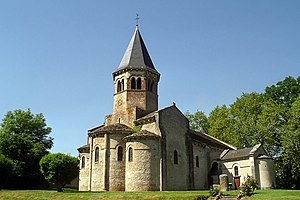Biocat
| Biocat | ||
|---|---|---|

|
|
|
| region | Auvergne-Rhône-Alpes | |
| Department | Allier | |
| Arrondissement | Vichy | |
| Canton | Gannat | |
| Community association | Saint-Pourçain Sioule Limagne | |
| Coordinates | 46 ° 5 ' N , 3 ° 16' E | |
| height | 326-404 m | |
| surface | 16.27 km 2 | |
| Residents | 845 (January 1, 2017) | |
| Population density | 52 inhabitants / km 2 | |
| Post Code | 03800 | |
| INSEE code | 03030 | |
| Website | Website Biozat | |
 Saint-Symphorien Church |
||
Biozat is a central French town and municipality ( commune ) with 845 inhabitants (as of January 1, 2017) in the Allier department in the north of the Auvergne-Rhône-Alpes region .
location
The place Biozat is located in the fertile and wooded landscape of the Bourbonnais at an altitude of about 360 m . The city of Vichy is located about 18 kilometers (driving distance) northeast; the city of Moulins is about 58 kilometers north. A few individual farms also belong to the community.
Population development
| year | 1962 | 1968 | 1975 | 1982 | 1990 | 1999 | 2006 | 2012 |
| Residents | 766 | 680 | 663 | 684 | 716 | 663 | 698 | 758 |
In the 19th century the number of inhabitants rose from around 1100 to over 1500. Due to the phylloxera crisis in viticulture and the mechanization of agriculture , the population of the municipality then fell continuously to the lows of the last few decades. The proximity to the city of Vichy and the significantly lower land prices in the countryside led to a slight increase in the population at the beginning of the 21st century.
economy
For centuries, the inhabitants of Biozat lived as self-sufficient farmers from agriculture, which also included viticulture; in addition there were regional retail trade and handicrafts. During the phylloxera crisis at the end of the 19th century came the wine to a standstill, but red, rosé and white wines are now being produced again in excess of the appellation de Val Loire ' are marketed. Some of the vacant houses in the village have been converted into holiday apartments ( gîtes ).
history
The place probably has Celtic origins; the Romans erected a milestone ( borne milliaire ) here. In the 10th century three hill fortresses ( mottes ) were built to secure and control the region; The place name Baizac has been handed down from the 11th century . The place and its priory belonged to the sphere of influence of the diocese of Clermont until the French Revolution ; they were also dependent on Cluny Abbey .
Attractions
See also: List of Monuments historiques in Biozat
- The former priory and today's parish church of Saint-Symphorien is a single-and - with the exception of the cornerstones , the upper part of the central apse and the bell storey of the tower - from rubble ( moellons ) erected construction of the high Romanesque with transept , three apses and an octagonal central tower . The west facade is largely unadorned. The barrel-vaulted nave is separated by a choir arch with a double window from the slightly raised crossing dome resting on trumpets . In the area of the crossing there are several colored Romanesque capitals ; In the apse, remnants of medieval frescoes were uncovered during restoration work in the 19th century. The church building was recognized as a monument historique as early as 1862 .
- On the north-east side of the church the Roman milestone with an inscription from the time of Emperor Hadrian (121) and another stone with possibly Celtic origins were placed in the 19th century ; Both stones were found in the immediate vicinity and added to the list of Monuments historiques in 1946 .
- Surroundings
- The Château de Fontnoble is a completely symmetrical, single-storey country castle from the 18th century with a mansard roof . Behind it is an only slightly smaller but otherwise similarly designed farm building. The building complex is privately owned and partly serves as a country hotel; it was recognized as a Monument historique in 2007 .
- The two-storey Château des Versannes (also Château de Biozat ), which also has a mansard roof, was built in the 19th century: The building impresses with its representative brick architecture with corner stones and window frames made of light sandstone .
literature
- Le Patrimoine des Communes de l'Allier. Flohic Editions, Volume 1, Paris 1999, ISBN 2-84234-053-1 , pp. 374-376.
- Andy Pinoteau: Église Saint-Symphorien de Biozat, ses peintures murales. Self-published 2012.
Web links
- Biozat, Viticulture - Info (French)
- Biozat, sights - photos + brief information (French)
- Biozat, church - photos + brief information (French)
- Biozat, church - photos + information (French)
- Biozat, Château de Fontnoble - photos + brief information (French)
Individual evidence
- ↑ Église Saint-Symphorien, Biozat in the Base Mérimée of the French Ministry of Culture (French)
- ↑ Borne milliaire et pierre celtique, Biozat in the Base Mérimée of the French Ministry of Culture (French)
- ↑ Château de Fontnoble, Biozat in the Base Mérimée of the French Ministry of Culture (French)

